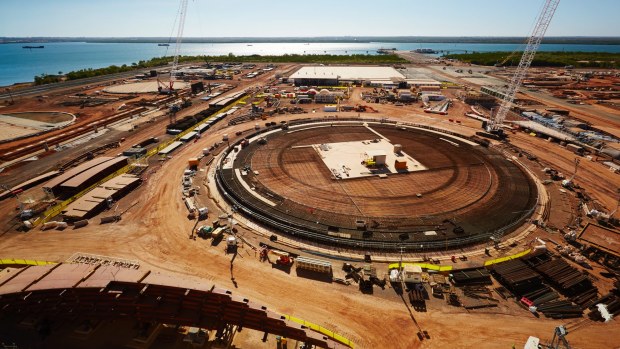Inpex, Chevron facing delays as worries grow on LNG start-ups

Japan's Inpex Corporation is thought to be struggling to keep its $US34 billion ($A43.5 billion) Ichthys liquefied natural gas project in northern Australia on schedule because of bottlenecks at a South Korean shipyard that is manufacturing a massive offshore platform.
The problems highlight the huge risks that remains in the start-up of $US180 billion worth of LNG projects in Australia during the next two or three years.

The start-up date for the $34 billion Ichthys liquified natural gas project, which will have an onshore processing site near Darwin, could be delayed until 2017.
Respected energy consultancy Wood Mackenzie is predicting delays not just at Ichthys but at Chevron's large Wheatstone LNG project in Western Australia, and a likely slower-than-expected ramp-up at the over-budget $US54 billion Gorgon project amid various challenges at the sites. The combined impact would be an 11-million-tonnes reduction in Australia's 2015-19 LNG output than the consultancy was forecasting six months ago.
The 120,000-tonne offshore platform for Ichthys, the world's largest semi-submersible platform, is due to set sail for Australia in early 2016 from the Samsung Heavy Industries shipyard in Geoje, South Korea. But the yard is stretched with other major construction projects, including Royal Dutch Shell's giant Prelude floating LNG vessel, also to be sited off the far north-west Kimberley coast.
A second large structure, a ship to be used to produce light oil at the Ichthys field in the Browse Basin, is being built at the Daewoo shipyard, also in Geoje.
Inpex chief executive Toshiaki Kitamura told investors earlier this month that the Ichthys project was 68 per cent complete and confirmed the start-up for late 2016, a date reiterated by Inpex's head in Australia, Seiya Ito, last week.
But the overstretched shipyard has long been seen as a problem, with Ichthys managing director Luis Bon last year describing it as a "hot-point issue".
Inpex general manager external affairs Bill Townsend said on Friday that areas of the project were "somewhat behind" and pointed to the "heavy workload" at the Korean yards.
"Projects the size, scale and scope of the Ichthys LNG Project are complex and challenging," he said.
"Various types of work are being conducted simultaneously to develop Ichthys. There are some areas of the project where progress is somewhat ahead or behind, but we are continuing to work diligently towards the target of commencing production by the end of 2016."
He said Inpex was working closely with contractors "to ensure they meet our project schedule."
But Wood Mackenzie is assuming Ichthys won't start production until mid-2017.
Asia-Pacific principal upstream analyst Angus Rodger said the venture essentially comprises four separate massive projects, two huge offshore structures, an almost 900-kilometre subsea pipeline, one of the world's longest, and the two-train LNG plant being built in Darwin. Bringing them all together will be a big challenge.
Mr Rodger said management of the construction of the two offshore structures had been "especially difficult" and he believed the work in the yards was behind schedule.
Wood Mackenzie believes Wheatstone, in which Woodside Petroleum now has a stake, is also running late after a lengthy and costly site preparation phase, and is assuming startup only in mid-2017. Meanwhile, first production at Gorgon has slipped further to late 2015, while the second and third trains are likely to be slower to start up than planned, it believes.
Chevron Australia managing director Roy Krzywosinski last week reiterated the plan to start up the three LNG trains at Gorgon six months apart. But Wood Mackenzie said the gap might stretch to nine months, meaning full capacity won't be reached until late 2018.
The consultancy said the Queensland coal seam gas-based LNG projects could start production more successfully than the large conventional ventures. The schedule for the start-up of the CSG-based plants has slipped relatively little, although only one of the six LNG trains being built at Gladstone's Curtis Island has so far begun production.
Meanwhile, Woodside's confidence in a decision in the second half of 2016 to construct the Browse floating LNG venture is not being shared by several analysts.
Deutsche Bank's John Hirjee estimates the venture needs oil prices to be at least $US80 a barrel for the Browse venture to be viable, and noted the bank doesn't expect prices to reach that level for at least two years.
Macquarie Private Wealth said assuming oil prices of even $US78 a barrel, it calculated Browse would deliver a rate of return of only 10.3 per cent, below Woodside's threshhold of 12 per cent, and take 10 years to pay back.
Mr Rodger said Woodside's bullishness on the Browse project, comprising two or three FLNG vessels in a remote area, had taken quite a few observers by surprise,
"It will be interesting to see how they look to potentially re-engineer or rephase that so that it becomes a more capital-efficient or more attractive project," he said. "Browse, to actually make it to FID [final investment decision], has to be an extremely competitive project from a global economic perspective."
Subscribe to gift this article
Gift 5 articles to anyone you choose each month when you subscribe.
Subscribe nowAlready a subscriber?
Introducing your Newsfeed
Follow the topics, people and companies that matter to you.
Find out moreRead More
Latest In Equity markets
Fetching latest articles